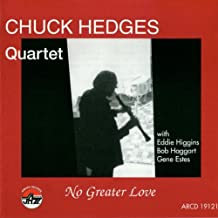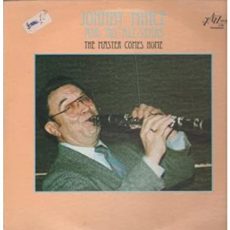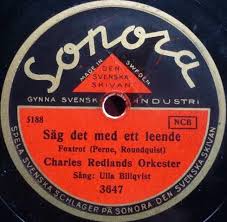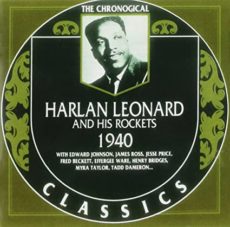
Daily Dose Of Jazz…
Chuck Hedges was born in Chicago, Illinois on July 21, 1932 and began playing clarinet while attending a military school. He received formal training under Claude Bordy and learned to play jazz on his own.
After studying at Northwestern University, Chuck joined George Brunis’s ensemble in 1953, remaining with Brunis through the end of the decade. He was active on the Dixieland revival scene in the 1960s, playing regularly at clubs in Chicago and Milwaukee, Wisconsin into the 1990s.
Working with Wild Bill Davison for most of the 1980s, he also worked with Alan Vaché and Johnny Varro. He with Ray Leatherwood, Gene Estes, Eddie Higgins, Bob Haggart, Duane Thamm, John Bany, Dave Baney, Charles Braugham, Howard Elkins, Jack Wyatt, Jim Vaughn, John Sheridan, Henry “Bucky” Buckwalter, Gary Meisner, Dave Sullivan, Mike Britz, and Andy LoDuca.
Clarinetist Chuck Hedges released several albums as a leader in the 1990s and 2000s before passing away on June 24, 2010.
More Posts: bandleader,clarinet,history,instrumental,jazz,music

Daily Dose Of Jazz…
Michel De Villers was born July 13, 1926 in Villeneuve-sur-Lot, France and learned to play alto saxophone as a teenager. He would later expand to clarinet and baritone saxophone. Playing in the latter half of the 1940s with Jean-Claude Fohrenbach, Django Reinhardt and Rex Stewart, he then joined the Edward VII Theatre band in Paris.
In the 1950s he worked in the bands of Geo Daly, Jack Diéval, André Persiany, and Gérard Pochonet. He also played with touring American musicians such as Buck Clayton, Bill Coleman, Jonah Jones, and Lucky Thompson. The Seventies saw De Villers as less active as a musician, working as a jazz writer and radio screenwriter. In the 1980s he became active again as an educator and performer, working later in his career with Christian Garros, Pierre Michelot, Roger Guérin, and Marc Fosset.
Saxophonist, clarinetist, and bandleader Michel De Villers October 25, 1992, Mont St. Aignan, France.
More Posts: bandleader,clarinet,history,instrumental,jazz,music,saxophone

Daily Dose Of Jazz…
Johnny Mince, born John Muenzenberger on July 8, 1912 in Chicago Heights, Illinois played with Joe Haymes from 1929 to 1934. He recorded with Red Norvo and Glenn Miller in 1935. Working with Ray Noble from 1935-37 and Bob Crosby in 1936 he went on to become a member of the Tommy Dorsey Orchestra in 1937.
Mince played with Dorsey through 1941 and was one of the participants in his Clambake Seven recordings before entering the military. After an extended stint to the end of World War II, he became a studio musician for several decades. He taught locally in New York City and played in small-time ensembles in the 1950s and 1960s.
1974 saw Johnny returning to play with the Dorsey Orchestra after Tommy’s death, then followed this engagement with the New Paul Whiteman Orchestra in 1976, Yank Lawson, Bob Haggart, and the World’s Greatest Jazz Band. As a member of the Great Eight, he toured Europe in 1983. He continued to play at jazz revival festivals until his retirement due to ill health.
He recorded as a leader only late in his life, for Monmouth Evergreen in 1979, Jazzology Records in 1980, and Fat Cat Jazz in 1982. Never receiving much recognition beyond that of his fellow musicians, he did not lead his own band. As an unknown musician, Tommy Dorsey invited him to become his partner in starting his first band but Johnny’s father talked him out of it due to risk. Clarinetist Johnny Mince passed away on December 23, 1994 in Boca Raton, Florida.
More Posts: clarinet,history,instrumental,jazz,music

Daily Dose Of Jazz…
Charles Redland was born Carl Gustaf Mauritz Nilsson on July 7, 1911 in Södertälje, Sweden. The son of a musician, he learned several instruments when he was young.
In the 1930s he was a member of bands in which he played alto saxophone, clarinet, trumpet, and trombone. During that decade he also worked as a leader.
On clarinet, he recorded with Benny Carter in Sweden in 1936. He composed and arranged jazz and popular music. He also composed for more than 80 films, as well as for radio and television programs. Alto saxophonist, Charles Redland passed away on August 18, 1994 in Stockholm, Sweden.
More Posts: bandleader,clarinet,history,instrumental,jazz,music,saxophone,trombone,trumpet

Daily Dose Of Jazz…
Harlan Leonard was born on July 2, 1905 in Kansas City, Missouri. He started his career in the Territory Band of George E. Lee in 1923, then moved to Benny Moten in 1924 and joined Thamon Hayes ‘ Kansas City Rockets in 1931 with several other musicians from the band. Disbanded in 1934, they formed the basis of the new Moten Orchestra. After Moten’s death in 1935, Leonard founded his own group, bringing several Moten musicians which became Harlan Leonard and his Rockets, and soon was one of the most famous bands in Kansas City.
After Count Basie’s departure for new YorkCity, he and Jay McShann were the strongest rivals. When the first Leonard band fell apart in 1936, he then took over the musicians of the Jimmy Keith band in 1937/38. In 1938 the young Charlie Parker also belonged to the band for five weeks but was dismissed because of unreliability.
In Chicago, Illinois in 1940, the band along with singer Myra Taylor recorded sessions for Victor Records. Returning to Kansas City in 1941, they toured the Midwest, then went to New York City but were unsuccessful so they returned home. Early 1943 Leonard went on a West Coast tour, playing one-nighters and a year engagement in Los Angeles, California.
After the band’s disbandment, Leonard remained in the Los Angeles area, performing occasionally in local clubs until retiring from the music business and working for the Internal Revenue Service.
Clarinetist, saxophonist, and Swing bandleader Harlan Leonard, who was one of the leaders of Kansas City Jazz with Jay McShann, and one of the links between the swing and the subsequent bebop, passed away on November 10, 1983.
More Posts: bandleader,clarinet,history,instrumental,jazz,saxophone


